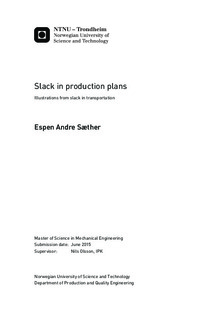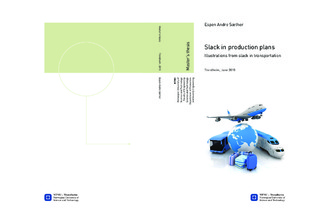| dc.description.abstract | The purpose of this thesis has been to define the meaning of slack in organizational context before reviewing how slack is viewed in manufacturing and logistics theory. Finally, an attempt has been made at reviewing literature and analyzing data in terms of slack in transportation industries. In manufacturing and logistics literature, the scope has been narrowed to briefly include ideologies and line of thought with a focus on relevance to slack. The same method is used for transportation production planning. In this case, the scope includes timetable planning and fleet/vehicle planning only.
Both qualitative and quantitative methods have been utilized to write this thesis. Literature used was found through searches in Google Scholar and BIBSYS Ask, in addition to webpages relating mostly to the actors involved in the data analyses section. These sources are considered to be of good quality, and should therefore provide reliable information. NSB granted access to their punctuality and utilization database, and NSB, Ruter, Avinor and Kolumbus provided data through Microsoft Excel spreadsheets. Data was also gathered from MiT, Norwegian.com and Flightradar24.com. The data used is considered accurate and reliable. Microsoft Excel was used to analyze and compile data.
The thesis has revealed that there are mainly two aspects related to slack in production planning. Slack that are present due to poor processes are considered waste and should be removed. If slack on the other hand is used as a tool to cope with uncertainty, it can be an enabler for quality. In transportation, slack is mostly mentioned related to buffer times that allow acceptable punctuality. The use of back-up vehicles/rolling stock/aircraft is also frequently mentioned.
Data analysis, together with the literature review, showed that there are differences in the use of slack among transportation industries and segments within industries. It was also clear, however, that in order to compare the use of slack in different industries it is necessary to account for the different characteristics of modes and business models. This includes the difference in uncertainty and consequence of poor performance. In relation to this, it has been shown that there are indications of a relationship between the amounts of slack and uncertainty. Further research could be directed towards quantifying the amounts of slack and the uncertainty in a more precise manner. Quantifying the relationship indicated in this thesis more accurately would allow a better and more direct comparison between the different industries and segments. | |

